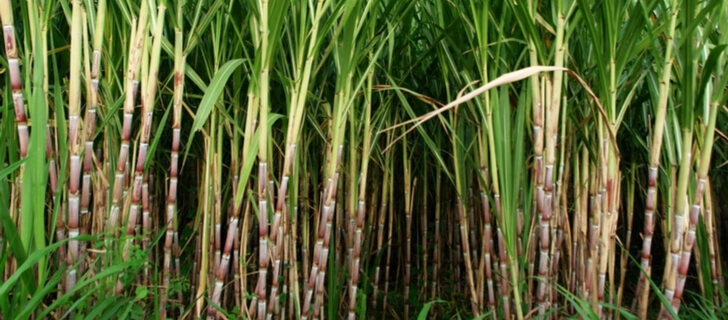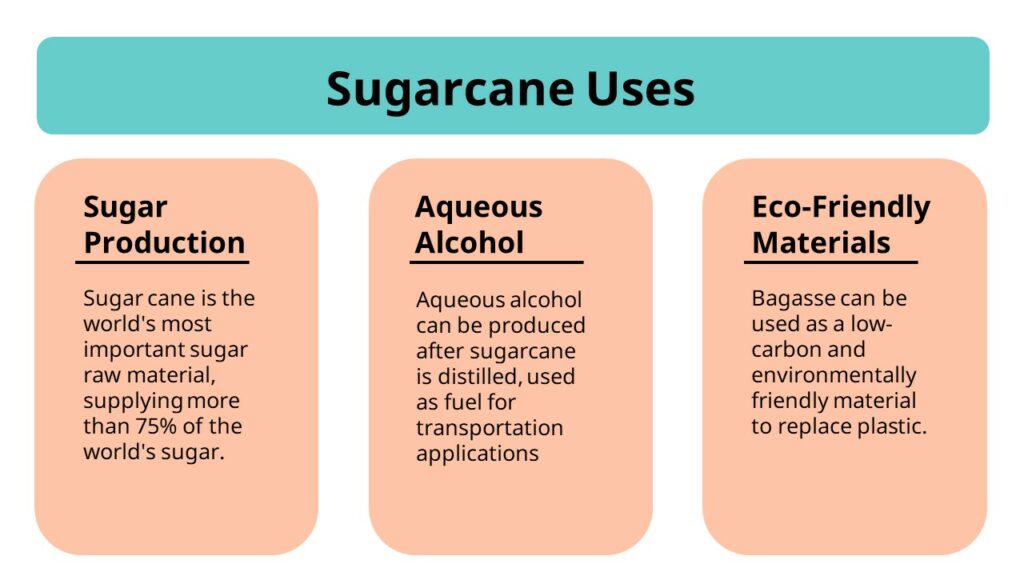Everything About Sugar Canes: What Are Sugar Canes Made Use Of For and Their Function in Global Farming?
Sugar canes act as a cornerstone of worldwide farming, mainly recognized for their function in sugar production. They also add to the development of spin-offs like molasses and ethanol. These elements not only sustain different markets however also influence economic security in country regions. Nonetheless, the cultivation of sugar walking canes deals with considerable environmental difficulties. Recognizing their complex role prompts further exploration into their farming techniques and sustainability initiatives.
The Agricultural Process of Sugar Walking Cane Cultivation
Although sugar walking stick farming might differ by region, the fundamental agricultural process stays constant. The initial action involves selecting high-yielding ranges suitable for local climates. Preparation of the soil is essential, frequently needing tillage and the addition of plant foods to enhance fertility. Planting usually happens throughout the stormy period, with farmers using either whole stalks or cuttings to develop new crops.As the plants grow, they require diligent care, consisting of weed control, pest management, and irrigation, depending on the ecological problems. Farmers monitor the sugar walking stick's growth cycle, which typically spans 10 to 24 months, prior to collecting. Gathering is labor-intensive, commonly carried out by hand or with specialized equipment, making certain marginal damages to the stalks. Complying with harvest, the walking stick is carried to processing centers. This careful growing procedure not only supports neighborhood economic climates but likewise plays a considerable function in worldwide agricultural techniques, adding to food and energy supplies.
Sugar Production: From Cane to Crystal
The journey of sugar production starts the minute fresh collected sugar walking stick comes to refining facilities. The initial step involves slicing the walking stick and cleaning to prepare it for extraction. Using high-pressure rollers, the juice is removed from the crushed walking cane, resulting in a pleasant liquid understood as sugarcane juice. This juice undertakes information, where impurities are eliminated with the addition of lime and heat.Next, the made clear juice is concentrated by steaming it down to develop a thick syrup. This syrup is after that taken shape by cooling down, making it possible for sugar crystals to form. The taken shape sugar is separated from the continuing to be syrup, referred to as molasses, via centrifugation.Finally, the sugar crystals are washed and dried, causing the acquainted granulated sugar (What Are Sugar Canes Used For). This process changes raw sugar walking cane into an item that is integral to different cooking and commercial applications, highlighting the significance of sugar in worldwide farming
Biofuels and Sugar Canes: A Sustainable Future
As the globe increasingly looks for sustainable energy remedies, sugar canes have actually become a promising source for biofuels. The biomass acquired from sugar canes can be converted right into ethanol, a renewable fuel alternative that significantly lowers greenhouse gas emissions compared to nonrenewable fuel sources. This procedure not only offers a cleaner energy source but likewise advertises power freedom for many countries.In addition, sugar walking stick growing sustains country economies by developing work in both farming and biofuel production sectors. Making use of sugar canes for biofuel manufacturing additionally urges agricultural diversification, which can enhance dirt health and wellness and lower dependence on single plants. Moreover, the by-products of sugar walking cane handling can be made use of for electrical power generation, in addition adding to a lasting power cycle. As countries endeavor to meet renewable resource targets, sugar walking canes are poised to play a vital function fit an extra lasting future in the biofuel landscape.

The Role of Sugar Canes in Beverage Manufacturing
Sugar walking canes play a significant role in beverage manufacturing, functioning as a primary ingredient in rum and adding to the sweet taste of numerous soft drinks. In addition, their all-natural juices are utilized in numerous drinks, enhancing taste and charm. This flexibility underscores the relevance of sugar walking sticks in the global drink market.
Sugar Walking Cane in Rum
Rum production is delicately linked to the cultivation of sugar cane, an essential plant that offers the essential fermentable sugars needed for fermentation. This procedure begins with the removal of juice from gathered sugar canes, which is after that either fermented straight or processed right into molasses. Yeast is contributed to transform the sugars into alcohol, causing a diverse variety of rum designs, from light to dark ranges. The geographical region where the sugar cane is grown significantly influences the taste profile of the rum, with variables such as dirt type and environment playing critical functions. Nations like Barbados, Jamaica, and Cuba are renowned for their rum manufacturing, reflecting the cultural and historical importance of sugar walking stick within the global beverage industry.
Soft Drinks Sugar Resource

All-natural Juice Manufacturing Makes Use Of
Along with its substantial duty in soft beverage manufacturing, sugar walking cane is likewise essential in the natural juice industry. The juice removed from sugar walking cane, called walking stick juice, is celebrated for its natural sweet taste and special flavor profile. This juice is commonly eaten fresh in different regions, particularly in exotic countries, where it is delighted in as a revitalizing drink. Furthermore, cane juice works as a base active ingredient in an array of natural fruit juices and shakes, improving both preference and dietary value. Its all-natural properties make it an appealing alternative to sweetening agents, appealing to health-conscious customers. In general, sugar walking cane's adaptability in juice production highlights its value in contemporary beverage offerings worldwide.
Technologies in Sugar Walking Cane Byproducts
Technologies in sugar walking stick byproducts are paving the method for sustainable remedies in numerous markets. Biofuels stemmed from sugar walking cane supply a different energy resource, while advancements in lasting product packaging are lowering dependence on conventional materials. These growths highlight the flexibility and potential of sugar walking cane past its key usage in drink manufacturing.
Biofuels From Sugar Walking Stick
Just how can the results of sugar cane add to sustainable energy solutions? The conversion of sugar walking stick right into biofuels offers a promising method for renewable resource. By making use of the coarse deposit, called bagasse, producers can produce bioethanol via fermentation processes. This bioethanol can function as a sustainable alternative to nonrenewable fuel sources, lowering greenhouse gas emissions and dependence on non-renewable sources. In addition, molasses, an additional result, can be fermented to create biofuels, optimizing source performance. The power created from sugar walking stick not only supplies a cleaner fuel source but also enhances the overall economic practicality of sugar production. By integrating biofuel production right into their operations, sugar walking cane markets can play a crucial function ahead of time lasting power remedies worldwide.
Sustainable Packaging Solutions
Sustainable product packaging remedies are significantly being created from sugar walking stick by-products, showcasing the adaptability of this farming staple. Technologies such as eco-friendly plastics originated from bagasse, the coarse deposit left after juice removal, are getting traction. These materials supply an environmentally friendly alternative to typical plastics, minimizing reliance on fossil fuels and decreasing carbon footprints. Additionally, sugar cane-based product packaging is compostable, breaking down normally without harming the setting. Business are now discovering these choices to align with customer demand for sustainability. As recognition of plastic air pollution expands, the adoption of sugar cane-derived packaging is anticipated to climb, placing sugar canes as a principal in the shift to greener product packaging solutions in numerous industries.
Economic Effect of Sugar Walking Cane Farming

Although sugar walking cane farming has deep roots in many economic climates, its economic impact expands much beyond agricultural production. This crop serves as a significant income source for millions of farmers worldwide, particularly in establishing countries where farming is a primary income. Sugar walking cane adds to local economic climates with job development in handling, harvesting, and farming. The sector additionally boosts development in related industries such as transportation, devices manufacturing, and food processing.Furthermore, sugar cane is an essential player in international profession, affecting international markets and rates. Nations that generate sugar walking cane usually rely on exports to enhance their economic security. The byproducts of sugar walking cane, such as ethanol and molasses, expand earnings streams for farmers and include worth to the agricultural field. Overall, the financial implications of sugar walking stick farming are profound, impacting not just farmers yet likewise national economies and whole neighborhoods.
Ecological Factors To Consider in Sugar Walking Stick Cultivation
While sugar walking stick farming plays a vital role in lots of economies, it additionally raises substantial environmental issues click site that can not be overlooked. The substantial use of plant foods and pesticides in sugar walking stick farming commonly leads to dirt degradation and water air pollution. Overflow from these chemicals can pollute nearby water bodies, hurting aquatic communities. Furthermore, the monoculture practices widespread in sugar cane farming lower biodiversity, making communities a lot more prone to insects and diseases.Deforestation is an additional crucial problem, as land is typically cleared to give way for sugar vineyards, click site resulting in habitat loss for wildlife and enhanced carbon exhausts. Additionally, the high water intake needed for sugar walking cane irrigation can strain local water resources, especially in deserts. As worldwide need for sugar proceeds to climb, addressing these environmental obstacles ends up being imperative to guarantee lasting practices in sugar cane farming.
Frequently Asked Inquiries
What Are the Nutritional Conveniences of Sugar Walking Cane?
The dietary advantages of sugar walking stick mostly include its high carb material, offering energy. Additionally, it has vitamins, minerals, and anti-oxidants that might sustain general health, though moderation is important due to its sugar content.
Just How Does Sugar Walking Cane Affect Local Ecosystems?
Sugar walking cane farming can substantially affect local communities by altering land use, influencing biodiversity, and calling for substantial water sources. Additionally, it may lead to soil degradation and pesticide drainage, interrupting surrounding habitats and wild animals populations.
What Is the Background of Sugar Walking Cane Growing?

Exist Alternatives to Sugar Walking Stick for Sugar Production?
Alternatives to sugar cane for sugar manufacturing include sugar beets, corn, and numerous tropical plants like sorghum and agave (What Are Sugar Canes Used For). These crops supply diverse sources of sweet taste, each with unique growing demands and ecological effects
How Do Climate Patterns Impact Sugar Cane Yields?
Climate patterns significantly affect sugar walking cane yields via temperature changes, rains amounts, and seasonal cycles. Dry spell or too much rainfall can impede growth, while suitable problems enhance photosynthesis, inevitably impacting the amount and high quality of the harvest. The trip of sugar manufacturing starts the minute newly gathered sugar cane gets here at refining facilities. The crystallized sugar is divided from the staying syrup, known as molasses, via centrifugation.Finally, the sugar crystals are washed and dried, resulting in the acquainted granulated sugar. Rum production is intricately connected to the farming of sugar walking cane, a vital crop that supplies the necessary fermentable sugars needed for fermentation. In addition, the monoculture methods common in sugar walking cane farming minimize biodiversity, making ecological communities extra vulnerable to parasites and diseases.Deforestation is an additional important issue, as land is typically cleared to make way for sugar haciendas, leading to environment loss for wild animals and raised carbon exhausts. her response Alternatives to sugar walking cane for sugar production include sugar beetroots, corn, and numerous exotic plants like sorghum and agave.